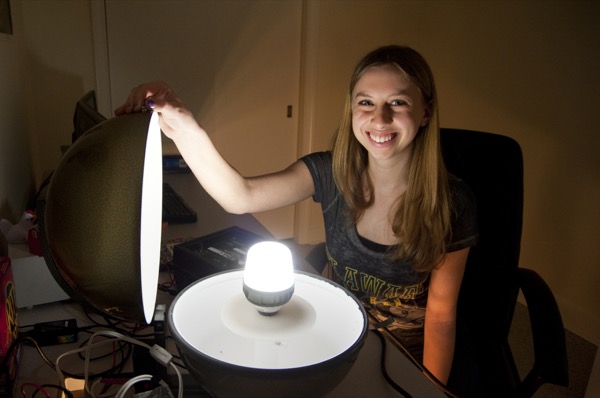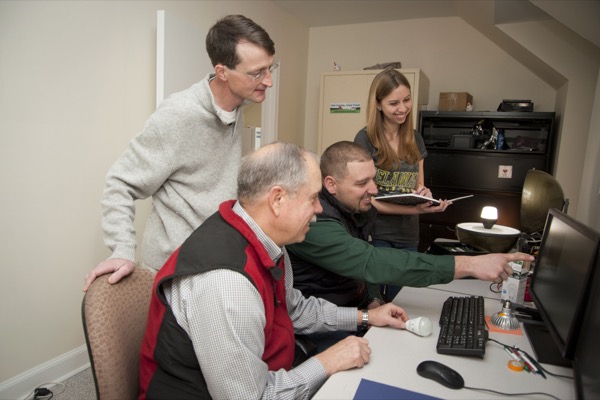


Poultry lighting
UD researchers examine combinations of lamps, dimmer switches for poultry houses
9 a.m., Feb. 16, 2016--When it comes to broiler chicken houses, one of the most important parts of the operation is the lighting in the house, which can prove to be a sizeable investment.
A problem growers run into when trying to decide which lamps to purchase is knowing what lamps (commonly referred to as bulbs) and dimmers (equipment that controls lamp light output and switches lamps on and off) work best together for their particular operation.
Research Stories
Chronic wounds
Prof. Heck's legacy
Now, thanks to a study from researchers at the University of Delaware’s College of Agriculture and Natural Resources (CANR), growers can determine the best sets of lights for their houses along with the best dimmers to pair with those particular lights by using an online selection tool.
The research team that developed the selection tool includes Sarah Morrissey, an Honors Program senior majoring in pre-veterinary medicine and animal biosciences; Eric Benson, a professor in the Department of Animal and Food Sciences (ANFS); Bob Alphin, instructor in ANFS and manager of the University’s Charles C. Allen Jr. Biotechnology Laboratory; Dan Hougentogler, a research associate in the department; and Bill Brown, a Cooperative Extension agent.
Lamps and switches
Beginning a few years ago when looking at the durability of alternative lights in poultry houses, Benson said they found that many lights that were supposed to last for thousands of hours were failing well before their advertised time of use.
Coupled with an evolving market that has introduced new lamps at a fast clip – which leads to growers wanting to adopt new technologies but unsure of how to go about doing that – the team members decided they wanted to get some baseline data to help growers determine how to best make their lighting selections.
Complicating the issue was the fact that the lamps run with a dimmer switch and are not simply run at full intensity all of the time.
“In poultry lighting, we don’t just put them in and turn the lights on. There’s a dimmer or two in the house, and it turns out that there’s a pretty significant interaction between the dimmer and the lamp and how it controls the lamp. Some lamps work really well with a given dimmer, some don’t,” said Benson.
Morrissey said there can be 80 to 100 lamps per house, and with the Delmarva region averaging two and a half poultry houses per farm, with some farms having up to 10 houses, the investment is significant, as lamps can cost up to $40 each.
Morrissey began working on the project during Winter Session 2015 and looked at lights from 17 particular lamps — 15 LED lamps, one incandescent lamp and one cold cathode fluorescent lamp. She also looked at eight dimmers with 21 different dimmer profiles that made them more or less compatible with different technologies, and used a spectrometer to measure five aspects of the lights per test.
Those five tests included measuring voltage; the milliamps, which is the current; the Kelvin temperature; the luminous flux, which is the light intensity; and the re-fire.
Benson said they looked at the re-fire because in a poultry house with 100 lamps, “the re-fire determines the lowest point that the dimmer and the lamp will work together and in a lot of cases, when they’re out in a big house, they don’t all go on at the same point. Instead of all 100 lamps going on at the same point, two might go on at one point and six at another, which makes it difficult for growers to program their lights.”
Sometimes, the lights don’t start and stop at the same point.
“If the lamps go all the way down to 10 percent, some of those same exact combinations that can go down to 10 percent during the dimming won’t come back on to produce light until 25 percent just because of the interactions between the dimmer and the lamp,” said Morrissey.
The group ended up performing over 3,000 tests and they did not find an ideal lamp that worked best with all the dimmer profiles, and no dimmer profile that worked best with all the lamps. That was one of the reasons the group decided to create the online selection tool.
Selection tool
The selection tool is a website that anyone, including poultry growers, can access and find the results of the research. Greg Keane, a database administrator for CANR, and Christy Mannering, a web developer for CANR, helped with the development of the website.
“People can see the results for the different combinations tested to see which lamp works well with which dimmer and vice versa,” said Morrissey.
Benson added that growers can also ask, “‘I have a dimmer, I have a lamp, what’s the best profile?’ There’s some different ways that they can use this to try to optimize what they’re doing.”
While the group didn’t find a “one-size-fits-all” solution to the problem, they did find some combinations that didn’t work well together, which can be just as useful to the growers.
“Initial investments-wise, if you have all these lamps, it may make more sense to consider buying a different dimmer that’s more compatible with those lamps because a dimmer could be $200-$300 depending on the technology but the lamp investment, say you’re getting $40 lamps and 100 total, that adds up,” said Morrissey.
Morrissey was able to present the research as part of Delaware Ag Week, which she said was a great experience.
As for if she ever envisioned herself studying poultry lighting and using that research as part of her senior honors thesis when she entered CANR as a freshman, Morrissey said definitely not.
“I knew I wanted to get involved in research but I hadn’t quite narrowed it down. I was keeping myself open to different options and then they needed some help and I made my way into this and became more and more interested in it. I wouldn’t stop talking about my light bulbs over the summer,” said Morrissey
Extension outreach
The group also had the help from Cooperative Extension as Brown helped the group realize how important it is for poultry growers to have the correct lighting in their houses and how it has been an ongoing issue for the industry.
“Besides Sarah doing an excellent job with this, I think this type of project is ideal because we’re involving an undergraduate in research and there’s an applied side where it’s dealing with a real world problem that she’s helped in answering, and we’re fulfilling our land grant outreach,” said Alphin.
Alphin said that they support the poultry industry through research conducted in the department and work closely with Extension agents like Brown to get that information to growers.
“We’re trying to help the broiler industry and with this project, we’re seeing a problem, we’re seeing research that is coming up with some answers and helping with a possible solution for the problem and we’re involving undergraduate students in the process. I just think that kind of says it all.”
Article by Adam Thomas
Photos by Wenbo Fan









